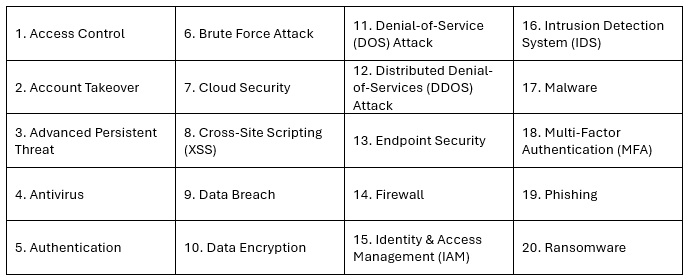So, I came up with a list of 20 of the most common cybersecurity terms for others to test their own knowledge, followed by an Answer Key with definitions.
Find out where you rank:
- 18–20 correct? You’re an A+ Cyber Star!
- 16–17 correct? Solid B – Nicely done
- 14–15 correct? You pass – but it might be time for a refresher
- Fewer than 10? Break out the books – your digital defenses need backup!
Take the Quiz!
Ready to test yourself? How many terms in this table do you really know?
ESSENTIAL CYBERSECURITY TERMS

Answer Key
- Access Control: A method of restricting access to systems, applications, or data only to authorized users.
- Account Takeover: When an attacker gains unauthorized access to a user’s account, often through stolen credentials.
- Advanced Persistent Threat (APT): A prolonged and targeted cyberattack in which an intruder gains access to a network and remains undetected for an extended period.
- Antivirus: Software designed to detect, prevent, and remove malicious software (malware) from computers and networks.
- Authentication: The process of verifying the identity of a user, device, or system, often using passwords, biometrics, or security tokens.
- Brute Force Attack: A trial-and-error method used to decode encrypted data such as passwords by systematically trying all possible combinations.
- Cloud Security: The set of policies, technologies, and controls deployed to protect data, applications, and infrastructure in cloud computing environments.
- Cross-Site Scripting (XSS): A vulnerability that allows attackers to inject malicious scripts into web pages viewed by other users.
- Data Breach: An incident where sensitive, protected, or confidential data is accessed or disclosed without authorization.
- Data Encryption: The process of converting data into a coded format to prevent unauthorized access.
- Denial-of-Service (DoS) Attack: An attack that aims to make a computer, service, or network unavailable to its intended users by overwhelming it with traffic.
- Distributed Denial-of-Service (DDoS) Attack: A DoS attack that uses multiple compromised systems to flood the target with traffic, making it even more difficult to stop.
- Endpoint Security: Security measures that protect endpoints-such as computers, mobile devices, and servers-from cyber threats.
- Firewall: A security device or software that monitors and controls incoming and outgoing network traffic based on predetermined security rules.
- Identity and Access Management (IAM): A framework of policies and technologies for ensuring that the right users have the appropriate access to technology resources.
- Intrusion Detection System (IDS): A system that monitors network or system activities for malicious actions or policy violations.
- Malware: Malicious software designed to damage, disrupt, or gain unauthorized access to computer systems.
- Multi-Factor Authentication (MFA): A security system that requires more than one method of authentication from independent categories of credentials.
- Phishing: A cyberattack that uses disguised emails or websites to trick individuals into revealing sensitive information, such as passwords or credit card numbers.
- Ransomware: A type of malware that encrypts a victim’s data and demands payment for the decryption key.
Become a Cyber Star!
Mastering these 20 cybersecurity terms will help you better understand the landscape of digital threats and defenses. Whether you’re an IT professional or simply interested in keeping your data safe, these concepts are the foundation of modern cybersecurity.
I’ve also created a downloadable, printable guide with all 20 terms, plus a few extras, with easy-to-understand definitions. It’s perfect for onboarding, team training, or just brushing up your own cyber smarts. You can find it here.
Want to learn more?
CGNET provides services in IT consulting, cybersecurity, generative AI user training, and more. Please take a look at our website and drop me a line with any questions you might have at g.*******@***et.com.





0 Comments